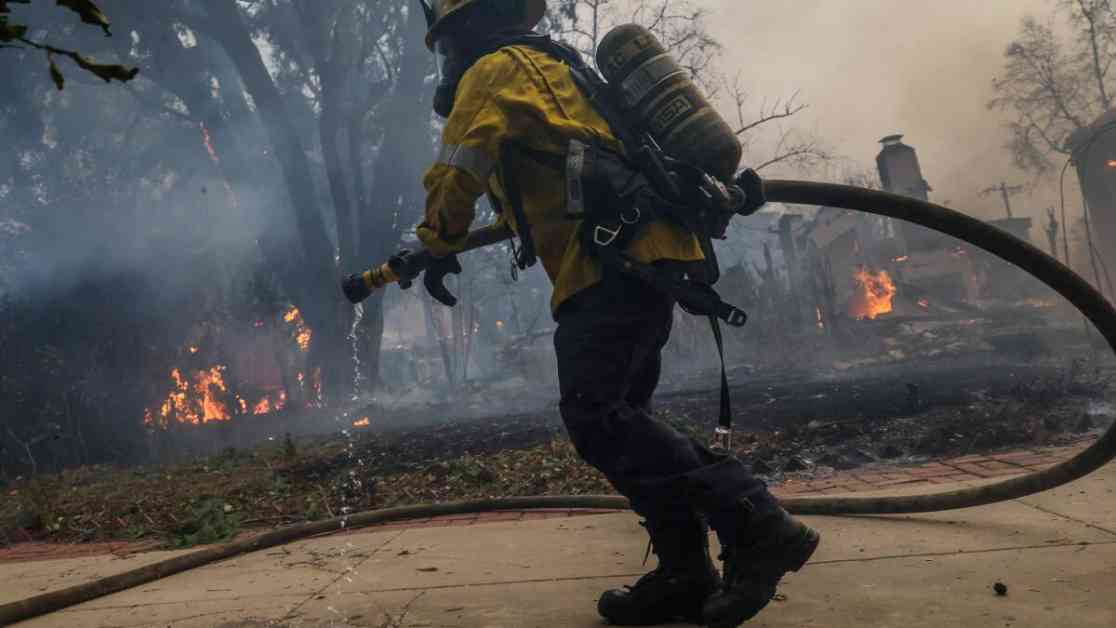**California Wildfires: How Dry Hydrants Are Impacting Firefighters’ Efforts**
As the wildfires continue to rage across the Los Angeles area, firefighters are facing significant challenges due to low water pressure and dry hydrants. These issues have highlighted vulnerabilities in the city’s water supply systems that were not designed to handle wildfires of this magnitude.
**Water System Limitations**
The local water supply system in the affected areas simply does not have the capacity to deliver the large volumes of water needed to combat massive wildfires that engulf entire communities. According to Martin Adams, the former general manager of the Los Angeles Department of Water and Power, the system was never designed for such scenarios.
In neighborhoods like Pacific Palisades, Altadena, and Pasadena, where different utilities serve the communities, firefighters have struggled with low water pressure and dry hydrants. The existing infrastructure is designed to handle smaller fires in individual buildings, not massive blazes that require a sustained and significant water supply.
**Challenges Faced by Firefighters**
When wildfires break out, firefighters often rely on aircraft to drop water and fire retardant. However, during the recent fires in Los Angeles, strong Santa Ana winds grounded water-dropping helicopters, forcing crews to depend on the limited water supply on the ground.
To alleviate the strain on the water system, city officials dispatched tanker trucks to provide water to firefighters in areas where supplies were scarce. This increased demand pushed the water system to its limits, with four times the usual water demand for an extended period.
Janisse Quiñones, DWP’s chief executive and chief engineer, stated that the firefighting efforts placed immense pressure on the water system, causing hydrants to run dry in hilly areas like the Palisades Highlands.
**Expert Perspectives on Water Infrastructure**
Water researchers and experts have weighed in on the challenges posed by the current water infrastructure in the face of escalating wildfires. Kathryn Sorensen, from Arizona State University’s Kyl Center for Water Policy, highlighted that local water systems are typically designed for smaller fires over limited time periods, not prolonged wildfires that engulf entire communities.
Gregory Pierce, director of the UCLA Water Resources Group, emphasized the severe limitations of the existing water system in Los Angeles. He noted that while it may be possible to expand water storage capacity in specific areas, the costs and logistical challenges are significant.
**Future Considerations and Investments**
As wildfires in the West grow larger and more intense, the question arises of whether investments should be made to expand water storage capacity in at-risk areas. Sorensen suggested that utilities need to evaluate the need for additional water storage in neighborhoods prone to wildfires, even if it comes at a high cost.
While there are no easy solutions to the challenges posed by wildfires and water supply limitations, experts agree that a comprehensive and long-term strategy is needed to ensure the safety of communities facing the threat of devastating fires.
**Conclusion**
The wildfires in California have underscored the critical importance of robust water infrastructure in firefighting efforts. As climate change fuels more frequent and intense wildfires, it is imperative that cities like Los Angeles reevaluate their water systems to better prepare for future disasters. The current limitations in water supply have exposed vulnerabilities that need to be addressed to protect communities and firefighters alike.




